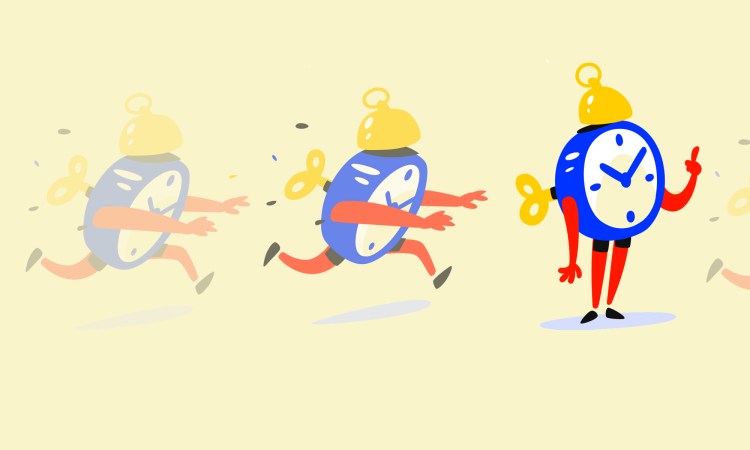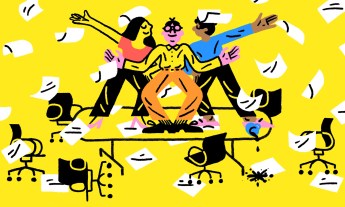
Regular super-short meetings can yield major results — they serve to bond teams, keep projects on track, avert misunderstandings and more, says organizational psychologist Steven Rogelberg.
A 10- or 15-minute meeting is a great tool that every leader should consider. Done effectively, short meetings with a focused agenda can have tremendously positive effects. Plus, they align with the existing research on limited human attention spans and fatigue.
Short meetings are rapidly spreading among companies. Global tech firm Percolate has set their default length for meetings at 15 minutes. Marissa Mayer, the former president/CEO of Yahoo, would create large time blocks filled with 10-minute meeting windows. While this would often result in 70 meetings per week, it allowed her to be highly responsive to employee needs, it made getting a meeting on her calendar much easier, and it helped projects and initiatives keep moving forward without delays. She also claimed that the meeting length led to employees coming in with tight agendas that led to success.
“Highly focused” and “short” are the hallmarks of a particular type of short meeting I want to focus on: the huddle. In sports, a huddle is a common activity — it may be planned or spontaneous, and it may occur before or after an action. At RSC Bio Solutions, a company that manufactures biodegradable industrial products, employees use the huddle as a way for a team and strategize, discuss, monitor, motivate or celebrate. The concept of the huddle is being applied in a range of organizations, including Apple, Dell, Zappos, Ritz Carlton and Capital One.
A huddle in the business realm:
• Is 10 or 15 minutes in length at most
• Typically occurs at the same time each day (or every two or three days)
• Starts and ends on time (you never want to run over)
• Is often done in the morning
• Usually occurs in the same place
• Usually involves the same people
• Asks for perfect attendance (if people can’t attend in person, they attend remotely)
• Often occurs standing up, if possible
Although each leader or facilitator can customize a huddle according to the needs of their organization and team, usually one question from one (or more) of the following categories is used to guide the agenda:
What has happened and any key wins
• What did you accomplish since yesterday?
• What did you finish since yesterday?
• Any key wins for you or the team that you can share?
• Any key client updates?
What will happen
• What are you working on today?
• What is your top priority for the day?
• What is the one most important thing you will get done today?
• What are your top three priorities for the day or the week?
Key metrics
• How are we doing on our company’s top three metrics?
• How are we doing on our team’s top three metrics?
Obstacles
• What obstacles are impeding your progress?
• Any stuck points you are facing?
• Any roadblocks the team can help with?
• Anything slowing down your progress?
You can also tailor your questions according to priorities and needs. For example, a company I worked with was trying to promote more cross-departmental teamwork. Every week, one of the huddles was designed to explicitly align with that goal and it took a few different forms. For example, attendees might discuss roadblocks, such as work processes that may be hurting teamwork. Or, they could focus on the positive and ask attendees for examples of how other teams helped them. These huddles helped the organization reinforce the current initiative and even monitor progress.
The meeting leader should make it clear that employees’ answers during huddles should be succinct to promote efficiency. It is also important for the leader to stress that the huddle is not about reporting to the leader. Instead, it’s about the team members communicating with one another, pulling together, learning together, and seeking ways to support each other. Relatedly, given the tight time limit, it is important to recognize that huddles are often about setting the table for additional conversations between team members offline. The walk from the huddle often turns out to be a rich opportunity for communication, or if the issue is substantive and involves most of the attendees, it can be taken up in a separate meeting.
One concern often associated with the daily huddle is that people are just too busy to engage in this practice. They simply find it difficult to find time on a daily basis to do this. I know that finding time to meet frequently is a genuine challenge. But from my experience implementing huddles at organizations and examining data on their effectiveness, I’ve found that these small investments of time yield big returns. By improving coordination and communication among team members, time is ultimately saved in the form of less rework, more teamwork, more support, and fewer miscommunications to resolve.
That said, there are two main hazards to actively guard against when engaging in these practices — the first is creating yet more time spent in meetings. Remember: Shorter meetings are designed to replace some longer meetings. Keeping that in mind, it is certainly acceptable and appropriate to schedule additional meetings in response to topics that emerge in huddles.
One organization I know instituted something called “magic time.” Basically, this was a standing meeting hour that the team kept open, no matter what, every other week (e.g., every other Monday at 10 AM). If a critical issue emerged in a huddle that needed substantive discussion, all team members knew that this time was available for follow-up. Thus, the huddle didn’t run over the scheduled end time, which brings us to the other hazard.
A second key hazard is not honoring the shorter meeting time. Running over the 10 or 15 minutes is highly problematic. Our research suggests, in fact, that running over may have more negative consequences on attendees than starting late — it serves to negatively affect any scheduled activities post-meeting, and by ending late, the meeting is breaking an implicit contract with attendees. This rupture results in stress, dissatisfaction and frustration among attendees, which not only affects them personally but can also spill over to their interactions with others. Honoring the end time mitigates these issues. What’s more, the increased sense of urgency from a short meeting with a hard stop time will decrease rambling and unproductive conversation.
A number of organizations take the practice of ending on time very seriously. Some companies’ conference rooms — Google has been known to do this at times — feature a giant timer on the wall. The timer counts down the time remaining for a particular meeting or topic and is visible for all attendees to see. Design and product development agency O3 World leverages technology they created to keep meetings from ending late. It warns attendees as the meeting’s end time approaches and will even start dimming the lights.
Some companies take a lighter approach to this challenge. At Tripping.com, the meeting leader must contribute to the team beer jar if the meeting does not end on time. Or, at Buddytruk, if the meeting runs over, the last person talking has to do 50 push-ups. These companies show they recognize the benefits of ending on time and the importance of gaining buy-in from the attendees.
As you can see, there are so many reasons to leverage shorter meetings. But let me close with a final piece of advice. Be sure to evaluate your regularly occurring huddles every few months or so. Given how frequent these meetings are, you want to keep them from getting stale. Send out a quick anonymous survey asking attendees what is going well and what isn’t going well, and solicit ideas for improvement. Then take the learnings and put them into practice — after all, a meeting is a shared experience and acting on feedback reinforces this. Most important, it will keep your speedy meetings fresh and effective.
Excerpted (with author updates) from The Surprising Science of Meetings: How You Can Lead Your Team to Peak Performance by Steven G. Rogelberg. Copyright © 2019 by Steven G. Rogelberg and published by Oxford University Press. All rights reserved.
Watch his TEDxUNCCharlotte Talk now:















